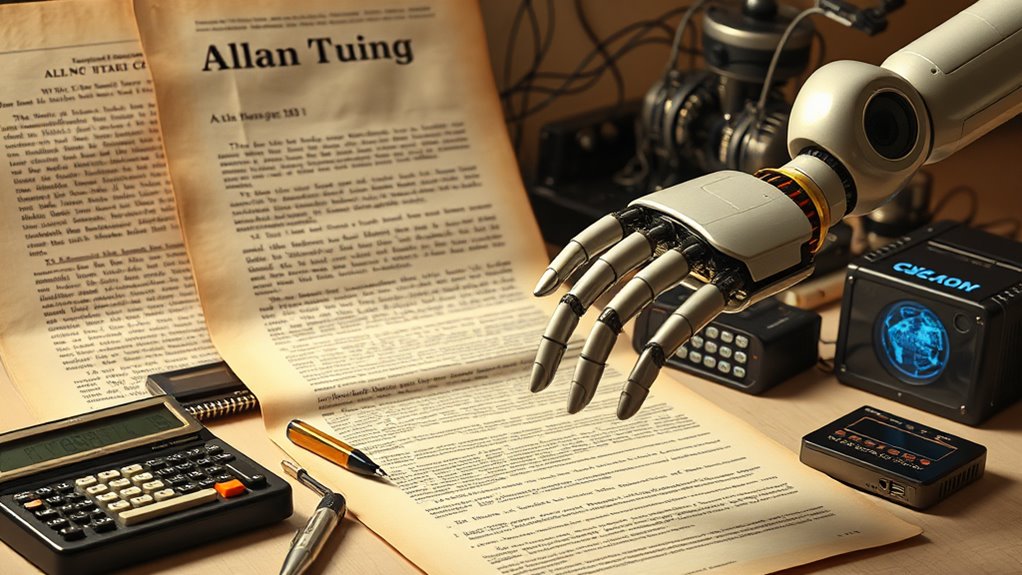You’re initiating a journey through AI’s rich history, starting with Alan Turing’s seminal 1950 paper that proposed machines could think. In the 1950s and 60s, researchers developed early AI programs focused on problem-solving and symbolic methods. By the 1980s, advancements in computer power led to machine learning and neural networks, simulating human cognition. Fast forward, and today’s AI excels in natural language processing and autonomous systems. Key milestones illustrate AI’s growing capabilities, from reactive machines to predictions of superintelligence. Alongside, ethical and societal challenges continue to shape AI’s rapid evolution. The intricacies of this evolution await your discovery.
Key Takeaways
- Alan Turing’s 1950 paper “Computing Machinery and Intelligence” laid foundational concepts for AI development.
- The 1956 Dartmouth Conference marked the formal birth of artificial intelligence as a distinct academic field.
- Machine learning emerged in the mid-20th century, enabling computers to improve tasks through data analysis without explicit instructions.
- Neural networks evolved, simulating human brain processes, critical for advancements in natural language processing and computer vision.
- Modern AI, leveraging machine learning and neural networks, excels in applications like autonomous vehicles and personalized healthcare solutions.
Definition of Artificial Intelligence
Artificial Intelligence (AI), a term that gained prominence in the mid-20th century, refers to the capability of machines to mimic human-like cognitive functions such as learning and problem-solving. Early AI was driven by exploring what constitutes intelligent behavior in humans through machine learning and neural networks. These were foundational in developing systems that could process data in a way that resembles human thought.
Machine learning, an AI discipline, emerged as researchers realized the importance of enabling machines to learn from data rather than being explicitly programmed. During the 1980s, neural networks gained traction, designed to simulate human brain processes. By replicating the neuron interaction in humans, these networks facilitated advancements in fields like natural language processing and computer vision. This allowed AI systems to interpret natural language, comprehend textual data, and understand visual information, bridging the gap between machine and human communication.
The late 20th century saw cognitive computing come into play, where machines started performing high-level thinking tasks. This era set the stage for AI’s evolution into tools that can not only interpret data but also learn, adapt, and enhance their problem-solving capabilities in a dynamic, human-like manner.
Early Milestones in AI Development
The 1950s and 1960s saw significant progress in AI research. Key developments included:
| Year | Milestone | Contributor |
|---|---|---|
| 1956 | Dartmouth Conference | John McCarthy et al. |
| 1959 | Development of the Perceptron | Frank Rosenblatt |
| 1965 | Creation of ELIZA, the first chatbot | Joseph Weizenbaum |
These innovations laid the groundwork for future advancements in AI.
The AI Winter: Challenges and Setbacks
Despite early enthusiasm, AI faced significant challenges in the 1970s and 1980s. Limited computational power and unrealistic expectations led to a period known as the AI Winter. Funding and interest in AI research declined, but this phase also encouraged researchers to refine their approaches.
The Rise of Machine Learning and Neural Networks
The 1990s and 2000s witnessed a resurgence in AI, driven by advancements in machine learning and neural networks. Researchers developed algorithms that allowed machines to learn from data, leading to breakthroughs in speech recognition, image processing, and natural language understanding.
Modern AI: Deep Learning and Beyond
Today, AI is powered by deep learning, a subset of machine learning that uses multi-layered neural networks. Innovations like Generative Adversarial Networks (GANs) and Transformer models have enabled AI to achieve human-like performance in tasks such as image generation and language translation. Companies like Google, OpenAI, and DeepMind are at the forefront of this revolution.
Types of Artificial Intelligence
With a clear understanding of what AI represents, it’s important to acknowledge the various categories in which AI manifests itself. AI is not monolithic; it has diverse kinds. In its simplest form, you have narrow AI, also known as weak AI. These are specialized systems designed for distinct tasks, like facial recognition or language translation. They excel at their specific functions but lack the broader cognitive abilities of humans.
The journey toward more advanced AI lies in general AI, which aims to develop machines with human-like capabilities across various domains. These systems can learn and reason in diverse contexts, akin to human cognitive functions. Currently, general AI remains theoretical, but it’s gaining traction as a future aspiration in technological development.
Finally, you encounter the concept of superintelligent AI, a hypothetical stage where AI surpasses human intelligence, potentially transforming societal structures. This idea brings both hope and caution.
In evaluating the architectural types, consider:
- Reactive machines: These operate based on current inputs without memory of past interactions.
- Limited memory: They can use past data to form educated choices.
- Self-aware systems: These represent the pinnacle of AI development, understanding their own existence and emotions, yet remain an aspiration for the future.
How Artificial Intelligence Works
Understanding the mechanics of artificial intelligence begins with recognizing its foundation in machine learning and algorithms. You see, machine learning is the process by which AI systems adapt and optimize by learning from data patterns. In the chronological journey of AI development, these systems started with simple algorithms but quickly evolved into complex structures known as neural networks. These are the backbone of modern AI, mimicking the human brain’s pathways to enhance deep learning capabilities.
To grasp AI’s workings, consider the elements below:
| Key Concept | Description | Role in AI |
|---|---|---|
| Machine Learning | Learns from data to improve accuracy and decision-making. | Core of AI development |
| Neural Networks | Simulate human brain activities and processes information. | Enhances deep learning |
| Cognitive Computing | Provides a framework for machines to process human-like tasks. | Powers intelligent behavior |
| Natural Language | Enables understanding and generation of human language. | Key in human-AI interaction |
Now, add robotics automation into the mix. It’s revolutionizing industries by employing AI to perform tasks traditionally requiring human intelligence. Initially, these systems could manage simple commands, but their capabilities have expanded remarkably. At every step, AI crossbreeds these technologies, enabling unprecedented levels of competence and cognitive computing that transform how machines perceive and interact with the world.
Applications of Artificial Intelligence
AI applications have permeated various aspects of modern life, reshaping industries and daily interactions alike. Since the mid-20th century, AI technologies have evolved remarkably, breaking new ground in several domains. Let’s walk through their applications:
- Chatbot Applications: Early AI chatbots like ELIZA set the stage for today’s advanced virtual assistants. These chatbots now perform crucial roles in customer service, exploring natural language processing to provide instant support and enhance user interaction.
- Healthcare Innovations: State-of-the-art AI is revolutionizing healthcare by enabling early disease diagnosis, treatment personalization, and patient monitoring. Algorithms interpret medical images with unprecedented accuracy, assisting doctors in making informed decisions. Telemedicine benefits from AI by streamlining patient-care pathways.
- Financial Analytics: The financial sector uses AI-driven analytics to predict market trends, manage risks, and detect fraudulent activities. As algorithms grow more sophisticated, they offer precise insights that help stakeholders make strategic decisions.
Autonomous vehicles now navigate streets independently, drastically impacting transportation. Meanwhile, personalized marketing tailors user experiences based on behavioral data, prompting businesses to increase engagement and optimize customer satisfaction. Today, AI’s influence is profound and pervasive, continuously redefining how you live, work, and interact.
Future of Artificial Intelligence
While AI’s current applications already shape life considerably, its future promises even more transformative impacts across multiple sectors. As technological advancements accelerate, you can expect AI to integrate deeper into healthcare, transportation, and finance. Future predictions suggest AI might drive innovation in personalized medicine, autonomous vehicles, and predictive analytics.
However, with AI’s growth, ethical implications become increasingly significant. You must consider privacy concerns, as the collection of vast data sets is necessary for many AI functions. There’s also the risk of biased algorithms, which can perpetuate societal inequalities if not adequately addressed.
Societal impact will be profound, reshaping labor markets and daily life. You might wonder about job displacement, as automation could replace certain roles. Yet, new jobs could emerge, necessitating a shift in workforce skills. Continuous learning and adaptability will be vital for managing this change.
Ethically, you’ll face the challenge of balancing AI benefits with potential threats, such as deepening societal divides. As AI’s capabilities grow, future generations must develop frameworks for responsible use, ensuring progress enhances humanity. By understanding these dynamics now, you’re better prepared to shape a future where AI serves society equitably and justly.
Frequently Asked Questions
Who Is Considered the Pioneer of Artificial Intelligence?
You’d consider John McCarthy a pioneer of artificial intelligence, advancing early concepts. Turing’s influence established foundational ideas. McCarthy’s work in symbolic reasoning and artificial neural networks paved the way for future AI development in a chronological context.
How Did the Turing Test Influence AI Development?
Turing’s influence launched machine learning by setting benchmarks. His test guided chatbot development, challenging AI’s conversational authenticity. It ignited ethical implications discussions and fueled AI skepticism, shaping a roadmap from theoretical concepts to practical applications over time.
What Were the Major AI Breakthroughs in the 20TH Century?
Imagine entering a new era: Neural networks took you by storm in the 1950s. Machine learning evolved, paving paths for expert systems. Natural language processing and robotics advancements in the late 20th century transformed AI’s landscape magnificently.
How Has AI Research Funding Evolved Over the Years?
You’ve seen AI funding evolve with government investment in initial research and the private sector’s growing interest over time. Research grants followed historical trends, leading to substantial increases, reflecting AI’s rising importance and promise across various applications.
What Role Did Academic Conferences Play in AI History?
Don’t judge a book by its cover. Academic conferences have fueled AI history through conference evolution, advancing research collaboration. They’ve enabled knowledge dissemination, enhanced networking opportunities, and amplified publication impact, shaping the AI field’s progress chronologically and contextually.
Conclusion
You’ve explored the fascinating history of AI, from Turing’s early ideas to today’s groundbreaking technologies. As you think about AI’s many abilities, it’s clear its potential is huge. From healthcare to hospitality, AI is changing almost every field, bringing both opportunities and challenges. Looking ahead, AI’s future will likely bring big changes, offering exciting advancements but also raising important policy questions. As you continue to follow AI’s journey, you’ll see its incredible impact on the world. Stay curious, think critically, and keep exploring its possibilities.





